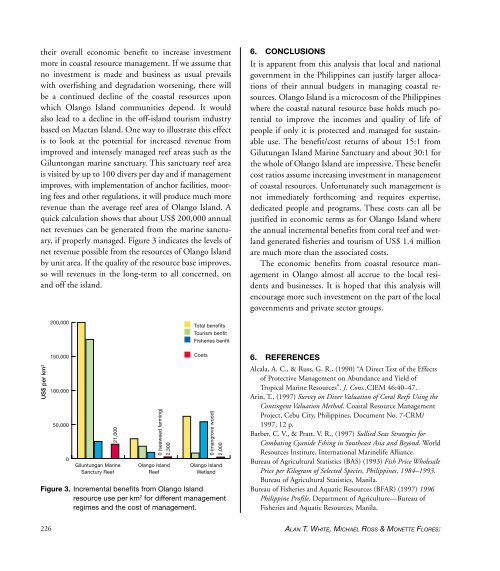Create successful ePaper yourself
Turn your PDF publications into a flip-book with our unique Google optimized e-Paper software.
their overall economic benefit to increase investment<br />
more in coastal resource management. If we assume that<br />
no investment is made and business as usual prevails<br />
with overfishing and degradation worsening, there will<br />
be a continued decline <strong>of</strong> the coastal resources upon<br />
which Olango Island communities depend. It would<br />
also lead to a decline in the <strong>of</strong>f-island tourism industry<br />
based on Mactan Island. One way to illustrate this effect<br />
is to look at the potential for increased revenue from<br />
improved and intensely managed reef areas such as the<br />
Giluntongan marine sanctuary. This sanctuary reef area<br />
is visited by up to 100 divers per day and if management<br />
improves, with implementation <strong>of</strong> anchor facilities, mooring<br />
fees and other regulations, it will produce much more<br />
revenue than the average reef area <strong>of</strong> Olango Island. A<br />
quick calculation shows that about US$ 200,000 annual<br />
net revenues can be generated from the marine sanctuary,<br />
if properly managed. Figure 3 indicates the levels <strong>of</strong><br />
net revenue possible from the resources <strong>of</strong> Olango Island<br />
by unit area. If the quality <strong>of</strong> the resource base improves,<br />
so will revenues in the long-term to all concerned, on<br />
and <strong>of</strong>f the island.<br />
6. CONCLUSIONS<br />
It is apparent from this analysis that local and national<br />
government in the Philippines can justify larger allocations<br />
<strong>of</strong> their annual budgets in managing coastal resources.<br />
Olango Island is a microcosm <strong>of</strong> the Philippines<br />
where the coastal natural resource base holds much potential<br />
to improve the incomes and quality <strong>of</strong> life <strong>of</strong><br />
people if only it is protected and managed for sustainable<br />
use. The benefit/cost returns <strong>of</strong> about 15:1 from<br />
Gilutungan Island Marine Sanctuary and about 30:1 for<br />
the whole <strong>of</strong> Olango Island are impressive. These benefit<br />
cost ratios assume increasing investment in management<br />
<strong>of</strong> coastal resources. Unfortunately such management is<br />
not immediately forthcoming and requires expertise,<br />
dedicated people and programs. These costs can all be<br />
justified in economic terms as for Olango Island where<br />
the annual incremental benefits from coral reef and wetland<br />
generated fisheries and tourism <strong>of</strong> US$ 1.4 million<br />
are much more than the associated costs.<br />
The economic benefits from coastal resource management<br />
in Olango almost all accrue to the local residents<br />
and businesses. It is hoped that this analysis will<br />
encourage more such investment on the part <strong>of</strong> the local<br />
governments and private sector groups.<br />
200,000<br />
Total benefits<br />
Tourism benfit<br />
Fisheries benfit<br />
US$ per km 2<br />
150,000<br />
100,000<br />
50,000<br />
0<br />
21,000<br />
0 (seaweed farming)<br />
2,300<br />
Costs<br />
0 (mangrove wood)<br />
2,000<br />
Giluntungan Marine Olango Island Olango Island<br />
Sanctury Reef Reef Wetland<br />
Figure 3. Incremental benefits from Olango Island<br />
resource use per km 2 for different management<br />
regimes and the cost <strong>of</strong> management.<br />
6. REFERENCES<br />
Alcala, A. C., & Russ, G. R., (1990) “A Direct Test <strong>of</strong> the Effects<br />
<strong>of</strong> Protective Management on Abundance and Yield <strong>of</strong><br />
Tropical Marine Resources”. J. Cons.,CIEM 46:40–47.<br />
Arin, T., (1997) Survey on Diver Valuation <strong>of</strong> <strong>Coral</strong> <strong>Reefs</strong> Using the<br />
Contingent Valuation Method. Coastal Resource Management<br />
Project, Cebu City, Philippines, Document No. 7-CRM/<br />
1997, 12 p.<br />
Barber, C. V., & Pratt, V. R., (1997) Sullied Seas Strategies for<br />
Combating Cyanide Fshing in Southeast Asia and Beyond. World<br />
Resources Institute, International Marinelife Alliance.<br />
Bureau <strong>of</strong> Agricultural Statistics (BAS) (1993) Fish Price Wholesale<br />
Price per Kilogram <strong>of</strong> Selected Species, Philippines, 1984–1993.<br />
Bureau <strong>of</strong> Agricultural Statistics, Manila.<br />
Bureau <strong>of</strong> Fisheries and Aquatic Resources (BFAR) (1997) 1996<br />
Philippine Pr<strong>of</strong>ile. Department <strong>of</strong> Agriculture—Bureau <strong>of</strong><br />
Fisheries and Aquatic Resources, Manila.<br />
226<br />
ALAN T. WHITE, MICHAEL ROSS & MONETTE FLORES:


















